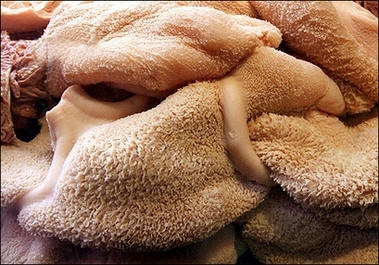Getting to The Heart and Guts of Spanish Cuisine
June 30, 2006 - Agence France Presse

For many lovers of good cuisine, offal is where they draw the line, thinking it best swiftly dumped in the garbage bin or left to hard-core foodies.
Barcelona native Paco de Horna Bosch-Lafulla is part of that growing hard-core crowd and also one of the sommeliers at El Bulli, one of the world’s most-watched restaurants, run by superstar chef Ferran Adria.
Bosch-Lafulla couldn’t be happier as he prowls Barcelona for his favourite eateries, showing how offal is making a steady comeback after years of decline in Spain.
Although one of his friends describes offal as “the parts that no one wants to eat,” Bosch-Lafulla said a growing number of Spanish are once again tucking into guts (and other parts) with gusto.
“It’s got flavor and texture, and it’s not monotone,” he said. “They are dishes that might not be beautiful to see, but they are cheap and flavorful.”
First stop on his guts tour is Menuts Rosa, an offal specialist in La Boqueria market, run by Maria Francisca Gabalda and her family since 1900.
She offers everything from hearts and lungs to feet and testicles, and customers waiting at her stall risk being splattered by bits of brain when one of her employees cleaves a sheep’s head in two with a large butcher’s knife.
“That can happen,” said Gabalda, squelching a smile.
“Offal was eaten a lot in the post-war years—in the 40s, 50s, 60s and 70s,” she said. “People liked it and it was cheap and flavorful.”
Once women became full-time workers, they had less time to spend in the kitchen.
“Cooking offal takes time and now, fewer people know how to make it. Women now know how to throw a steak on the grill—bam, bam!” she said, turning her hand over like she’s flipping an entrecote, “and you eat it right away.”
She sells some 70 to 80 kilos (140 to 160 pounds) of tripe a day, “and more on Fridays and Saturdays,” at three to four euros (up to five dollars) per kilo (2.2 pounds)—three to five times less than the cost of most steaks in the market.
But preparing offal can be time consuming, needing slow cooking to tenderise the meat. A good tripe dish can take a day of preparation and some chefs even give it an extra day soaking up flavors before serving.
“From the 80s to now, it went like this,” she said, skiing her hand downward to show the popularity decline, which hit a low around 2000 with the outbreak of mad cow disease, which deterred many European meat-eaters.
“Now, Ferran Adria and other new wave chefs are working on bringing it back,” she explained.
Bosch-Lafulla said El Bulli, located in Roses, about two hours north of Barcelona, has had many forms of offal on the menu for years, referring back to a 1993 cookbook he owns.
A wave of South American and African immigrants to Spain has also helped boost offal’s popularity, and many now line up every day to buy Gabalda’s products and cook them in the traditional ways from back home.
Next on the guts lovers tour is the Bar Cafeteria Tupinamba, where Basco-Lafulla orders orejas and caillos—pigs’ ears and tripe stew.
For him, the ears are the perfect starter. Crunchy and chewy, they not only have their own flavor, but also absorb the taste of the olive oil and paprika with which they are prepared.
The tripe is served Madrid-style, bubbling in a dish with ham, sausage, occasional bits of pigs’ feet and varying degrees of hot pepper. In many parts of Spain, it is traditionally eaten as a hearty breakfast.
“People would start the day eating like this,” he said. “It’s like a continental breakfast.”
Next, he strolled a couple of blocks to the Jofama cafe for a cap i pota—Catalan for “head and feet”—a salad made with calf bits along with black olives and slivers of red and green peppers. Served chilled, it’s surprisingly refreshing in warmer weather.
Finally, he pulled into Alaska Bar and Restaurant for morros—deep fried bits of pork snout served at room temperature and doused with rock salt.
“It’s like popcorn! No wait! It’s like pork-corn!” he howled.
Ca L’Isidre is one of Barcelona’s best-known restaurants and a classic destination for lovers of dishes like tripe and brains. “We’ve had them both on the menu for 38 years,” said head chef Nuria Girones.
“When money started coming into the region, people wanted to eat other stuff,” said her father, Isidre Girones.
“It was part of the new wave of cooking, but now, people want to go back to their roots and to find authentic products.
“It’s not important whether it’s showing up in new wave kitchens or not, but it’s very important that it’s cooked right,” he added.
“Tripe needs one day of cooking and one day of resting before we serve it,” he said, “otherwise, it’s rubbery.”
“They are the flavors of our life,” summed up Bosch-Lafulla. “Caviar is great, but I prefer offal.”